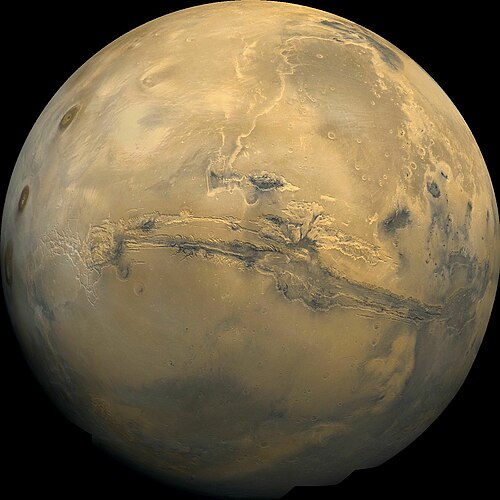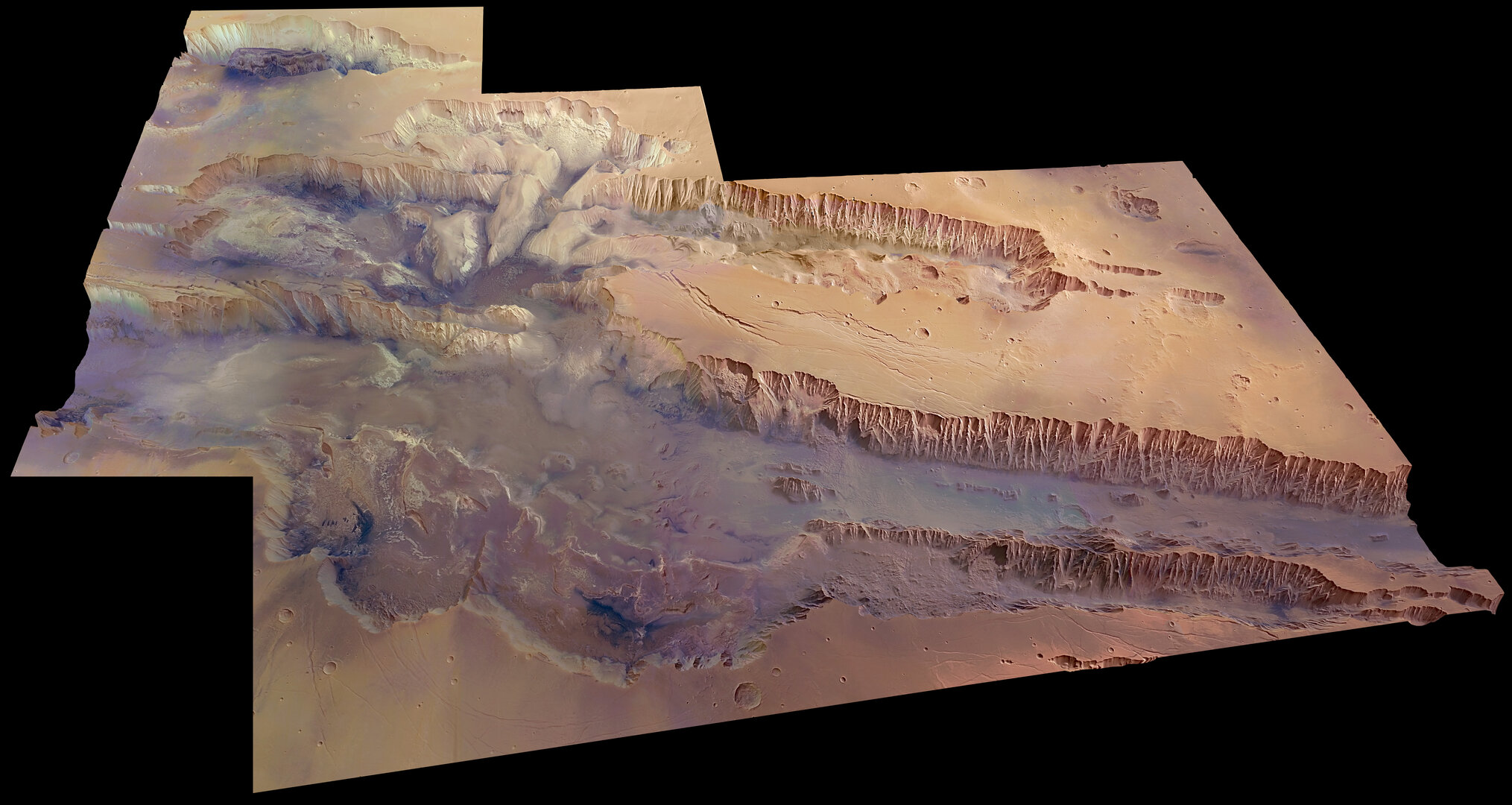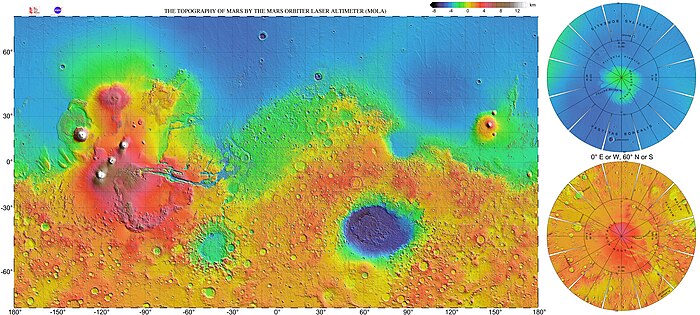Settle The Stars – Mars
Hello folks, this is Alexander Winn.
Today we’re visiting one of the most popular destinations in our solar system: Mars. The Red Planet has been the subject of countless sci-fi adventures from the time that mankind realized it was a place we could visit. From the 1800’s when observers first believed they saw artificially created canals on the surface right up through today we have hoped to find life on another planet, and Mars has taken center stage in the search for aliens.
Our trip to Mars will take us face-to-face with some of the most massive geological features and mysterious eccentricities that exist in our solar system – and we’ll learn about what they are still teaching us about Mars, Earth and the rest of the solar system. Interspersed throughout the journey we’ll see examples of past observations and scientific theories have been challenged and shaped by continuous study and reflect on some of the cultural and historical impacts of the planet that we carry even today.
Today’s visit will be imaginary, but it might not be long before you can book your own ticket to Mars. There are several space agencies and private corporations currently racing to be the first to offer passage to the planet. The current front-runner is SpaceX, the venture headed by Elon Musk. So far several successful tests have been conducted with unmanned visits to Mars slated for around 2025. SpaceX hopes to begin large-scale commercial trips in the 2030’s, so intrepid explorers should begin saving now as a ticket could cost you up to half a million dollars.
Fortunately for us, today’s visit is free, safer, and thankfully… shorter.
The real deal will be a grueling seven-month swing through space in what’s known as a transfer orbit – instead of making a direct line from Point A to Point B, space travel requires a little more finesse. Planetary alignments are carefully calculated to anticipate future locations before the craft is lobbed like a shot-put from one planetary orbit to another. Dates and times are important here, and if you miss your launch window you could find yourself stranded (on Earth or on Mars) until the next favorable alignment.
Seven months is no time at all to an astronomer, but to a traveler it can seem an eternity once the novelty of life in zero gravity wears off. For most of the journey there won’t be much to see out the windows aside from the stunning starscape, but some exercise to prevent atrophy and a couple hundred in-flight movies should help pass the time.
As Mars approaches you will have a rare view at the inspiration for uncountable millions of humans who have gazed up at the planet from Earth. The deep orange-red color of abundant iron oxide represented blood and fire to many ancient stargazers – small wonder that the planet became associated with war, fire and destruction to many of them.
Many know Mars to be the Roman god of war, carried over from the Greek god Ares – in fact, in modern Greek the planet is still referred to as Ares. But such a prominent and unique object in the sky was the focus of interest for many other cultures, including the Chinese who named the planet the “fire star” which is an omen which also foretells the coming of war, bloodshed and destruction. In Sanskrit the planet is called Angaraka, after another deity of war. But not all cultures attributed the red color to calamity – the ancient Egyptians named the planet for the red god Horus in charge of kingship and the sky, and ancient Hebrews called it Ma’adim, or “the one who blushes”.
The symbol of the circle and projecting arrow that many recognize as the symbol of the male sex was first seen from manuscripts in the Middle Ages to represent the planet as well as the element of iron. The symbol is actually a pictograph depicting an ancient shield and spear, holdovers from the cultural association with war.
From the window of our ship, it is clear no wars are currently raging on Mars, in fact from here it appears still and quiet. Even though we’re close, the smaller size creates an illusion of distance as the curvature of the planet is much more pronounced than Earth would be at this altitude as Mars is only about half the diameter of Earth.
Depending on the timing, you may be able to see the two moons of Mars, Phobos and Deimos named after the Greek god Ares’ children. Evidence suggests that the moons are composed of materials normally found in asteroids, leading to one theory that they are actually foreign objects captured by the planet’s gravity – but there are also clues that support another theory that Phobos could have originated from materials ejected from Mars itself as the result of a massive impact event.
Invisible from our little window are our Earth visitor predecessors also circling in orbit around the planet. There are about a dozen man-made satellites currently circling Mars, some long dormant, some still busily collecting data. Beginning with the first successful flyby in 1965 by NASA’s Mariner 4 probe and first ever successful orbit achieved by Mariner 9, the constellation of spacecraft has only grown. Most of the satellites still in orbit today are too small to be viewed from our vantage point – if they were, they’d probably be a little too close for comfort.
Evidence of past calamities is clearly visible though, from massive scars still visible on the surface. The southern half of the planet is pockmarked by craters from ancient collisions. Large meteors have little difficulty reaching the surface through the thin atmosphere, visible from here as a thin band on the horizon.
By contrast, the northern part of the planet is relatively smooth. These are vast plains, flattened out by lava flows millions of years ago. One theory is that billions of years ago Mars was impacted by a massive object hundreds of miles across. That would make Mars the site of the largest known impact crater in the solar system, as large as Europe, Asia and Australia combined.
Shining bright white against the reddish-brown soil we can clearly see the polar ice caps, one of the most promising early discoveries about the planet. Finding frozen water on one area of the planet while being absent from other areas could suggest an intermediate zone where liquid water can exist. Such a zone would bode very well for the hope that Mars could be capable of supporting life – either Martian life in the past or visitors from Earth in the future.
As we descend for landing, some of the major geological features of the planet become more pronounced. Great mountains begin to rise up, with valleys, plains and even canyons carved throughout the landscape. One mountain in particular is unmistakable: Olympus Mons.
The gargantuan shield volcano is easily visible from space, and one of the largest volcanoes in the solar system. Towering two and a half times as high as Mount Everest, the shield volcano sprawls over an area roughly the size of France. We could visit it up close, but ironically it wouldn’t be all that impressive – the shield is so large that the curvature of the planet would prevent us from seeing the entire profile of the mountain. Even if you perched right on top, the bottom would be out of view.
Another unmistakable feature to point out on our way down is the massive system of canyons known as Valles Marineris. This sprawling network of canyons stretches over 2,500 miles across the face of the planet and gouges nearly 23,000 feet deep. If you were perched on the edge, the opposite canyon face would be up to 120 miles away – way too far to even see across.
The Valles Marineris and Olympus Mons appear to have formed around the same time as each other, along with a huge number of other massive volcanoes and lava plains on the planet during the violent Heperian Period of Mars’ geological history which ended about three billion years ago. During this cataclysmic transformation, Mars experienced planetwide volcanic activity and catastrophic flooding which carved massive canyons across the planet’s surface.
Now safely aground at our landing site, it would be hard to believe such a period of upheaval happened here. The ground is rocky and flat, and the sparse atmosphere whips up the dust to welcome us after our long journey.
One of the first stops as tourists has to be to visit an old friend. Not far from where we landed, a small metal rover waits for our welcome.
This particular one is called Sojourner, and it’s been waiting for us here since 1997. NASA lost contact 85 days into what was supposed to be a seven-day mission, and it’s been here accumulating dust and awaiting rescue. About the size of a dog with six wheels and a little solar panel, this experimental rover allowed NASA scientists to develop new methods for movement and control that would improve later designs. Slowly and carefully (as Sojourner’s top speed was about 1 centimeter per second) it managed to journey 330 feet from its home base. And now with us here, Sojourner can retire to a pampered life in Mars’ first museum.
Since the first successful rover Mars 3 achieved by the Soviets in 1971 there have been seven sent to the planet over the years, with two NASA rovers currently active on Mars right now (Curiosity and Perseverance), and the Chinese Tianwen-1 is en route to join them shortly. The seven rovers are spread out across the planet so we can’t visit them all on our trip today, but they have collected invaluable information about the atmosphere and geology of the planet that continue to make a human mission to Mars a reality.
One of the most daunting challenges faced by engineers designing these manned and unmanned missions is this dust – all this dust. It’s exceptionally fine, like talcum powder, and covers the planet so completely that no environment is spared. For mysterious reasons, it even kicks up into massive planet-wide dust storms every few years. The dust can cover camera lenses and solar panels, clog mechanical components and disrupt radio communications. It will be a major part of life for early Martian explorers, and has already been the bane of several rover missions so far.
The dust is carried on the wind of Mars, which can blow quite strongly considering how thin the atmosphere is. The air pressure is exceptionally low compared to Earth, less than 1% of what we’re used to. At that pressure, the air must move at a high velocity to mobilize dust, and wind speeds have been clocked at an average of 10 to 20 miles per hour, reaching as fast as 70 miles per hour in a dust storm.
Compared with the nitrogen and oxygen-rich air we breathe on Earth, the atmosphere on Mars is almost entirely composed of carbon dioxide. It is a heavily oxidizing atmosphere, which explains the rich orange-red color of the planet imparted by the iron oxide present in the dust and soil.
As we look around, the sky is colored a similar reddish orange, thanks to the dust particles, but as the sun sets we can look forward to a brilliant sunset of orange and gold that changes to a lavender and blue twilight against a curtain of high-altitude clouds. As night gradually falls (twilight lasts a bit longer with light scattering through the dust in the air) we would see the stars shine. The dust dims them about a magnitude of brightness, but that’s still better than you’ll get in most suburbs on Earth due to light pollution. And here on Mars they don’t seem to shimmer and twinkle – the atmosphere is too dim for that.
Nighttime also gives us a better sense of the movement of the planet we’re standing on. A day on Mars is remarkably close to a day on Earth – only 39 minutes and 35 seconds longer than we’re used to. If you’re curious how adjusting to the new sleep schedule is, just ask the NASA engineers responsible for keeping Curiosity and Perseverance busy all day. They keep a Martian schedule for their work, though the payroll department probably finds it less entertaining.
Not that we’re bothered thinking about pay while looking at the Martian night sky. In the east we can watch Phobos rise from the western horizon and march across the sky quickly, setting again in the east after taking only 11 hours to cross the sky. It appears to us as only a third of the size of the moon, but the pale color would make it stand out like a bright pebble.
Deimos, on the other hand, rises from the east and sets in the west – not because it moves in the opposite direction, but because its orbit is much slower than Mars rotates on its axis. It is larger than Phobos but much farther away, so to us on Mars it would appear more like a very bright star.
If we had visited in 2014, we would have had a spectacular show indeed. The comet Siding Spring made a close pass of Mars – so close, in fact, that the entire planet may have been engulfed in the tail-like coma for a brief time.
As for other light shows we might enjoy, you might have heard of an aurora phenomenon detected on Mars back in 2016. Unfortunately, we wouldn’t be able to view the sky lights ourselves, as the light show is only visible in the ultraviolet spectrum during the day. But our electronic sensors can sure enjoy the spectacle, and they’ve taught us a lot more about Mars.
On Earth the aurora is caused by the collision of charged particles from the sun with molecules in our upper atmosphere. They only occur near the poles because these charged particles slide off the planet’s magnetosphere like water across a giant balloon, circling around to the poles where the magnetic field originates and sparking the light show.
Mars has only vestiges of a magnetosphere left. The magnetic field collapsed about four billion years ago, theoretically after taking several large hits from asteroids. Without the planetary shielding, the Martian atmosphere has gradually been stripped away by the solar wind. NASA’s MAVEN orbiter studies the upper atmosphere of Mars, and according to the data collected it appears the planet was once surrounded by a more robust, humid layer of air before it was lost to the sun’s energy.
After a night of stargazing, a new Martian day means more exploration for us here on the surface. One of the most important places for us to visit has been impenetrable for our orbiters and landers so far, and the most promising for well-preserved evidence of life-supporting conditions: caves.
A series of cave entrances has been spotted by one of NASA’s satellites along the face of Arsia Mons, a large volcano in the Tharsis Basin southeast of Olympus Mons. Likely formed as part of the volcanic process, these caves are well protected from meteoroid impacts, erosion and damaging radiation from the sun. Obviously, they’re impossible for a wheeled, solar-powered rover to explore, but for humans a little off-world spelunking is Space Exploration 101 so we can get a close first look ourselves.
Inside we might find evidence of liquid water, either in molecular traces, water-requiring mineral deposits or flow erosion. All these clues have been spotted elsewhere on the planet, usually in the basins of craters or up against sheltering cliffs and mountains. In 2018 and 2020, large salty lakes of liquid water were detected by the European satellite Mars Express. As hypothesized, these lakes only exist underground as far as we know, where the sun’s radiation can’t reach them.
It is a testament to the power of the long-term forces of transformation at work at the planetary scale, to find so much evidence of flowing rivers, torrential floods and even oceans all around us – but not a drop to be found on the surface today.
Even if hidden underground or locked in icy stasis at the poles, the presence of water bodes well for the ability of any planet to sustain life. On Earth we have learned that life has a way of surviving in even the most unimaginable conditions, but one condition is essential: water. Water dissolves life-giving substances and allows necessary chemical reactions to take place. It can also act as an insulator, stabilizing temperatures to make it easier for fledgling life to gain a foothold. Life as we would recognize it is simply impossible without water.
Alongside H20, there is one other essential chemical component generally understood as essential for life: carbon. The multi-tool of the periodic table, carbon’s unique expertise as a molecular brick-and-mortar building block makes it the go-to backbone of essential molecules from sugars to proteins and everything in-between. Fortunately, with an atmosphere rich in carbon dioxide, Mars has carbon in spades.
So, we have spent time searching for the requirements life needs to survive, but what about the outputs it generates? Can we detect evidence of life by looking for byproducts of living processes? As it turns out, we’ve been looking there, too.
A common metabolic product of living organisms is a simple molecule called methane. Methane doesn’t last long in the wild, especially in a radiation-rich atmosphere of Mars, so it’s presence would mean an active source. As it turns out, satellites around Mars have detected large plumes of methane on the planet which suggest localized points of origination somewhere near the surface or deep underground. Scientists and E.T. enthusiasts should keep their excitement in check however, as there are several geological processes that could produce similar plumes. But it is a very promising sign that will require further confirmation.
Even if life does not currently exist on Mars, it is possible it once could have in the past. And these possibilities are encouraging to some who believe that what was once possible could be possible again. While still far outside the realm of scientific reality, the theoretical possibility of terraforming Mars – that is, enacting global changes for the purpose of making it more able to sustain life similar to Earth – is an enchanting goal.
Just how to go about such an enormous feat is still in question. Some hypothesize that by introducing bacteria or other microorganisms capable of surviving in the harsh environment the composition of the atmosphere could be gradually changed until larger and more human-friendly organisms like plants could be supported, in turn paving the way for insects or small animals.
Another possibility involves using massive mirror arrays in space or geothermal outlets on the surface to gradually warm the temperature of Mars to unlock greater quantities of life-giving water from the polar caps.
Regardless of the path chosen, even after researched and prototyped to perfection these processes would require investments of money, time and materials on a scale unfathomable to us today. And there are still currently insurmountable challenges that could threaten the entire effort before it even begins: without a magnetosphere, what’s the point of enriching an atmosphere that the sun will only continue to blow away? Is it worth terraforming a planet to support life on a world without any active mineral-recycling tectonic activity as we know it?
As early explorers, our job is to continue the hard work of the satellites and rovers (and the scientists and engineers who control them) to find the answers to these questions. And even if we don’t get right to terraforming the planet, there is still plenty for us to do in preparation for future visitors.
So now with our sightseeing complete, the hard work begins. The exploration of Mars means more to humankind than the opportunity to learn more about planetary formation and evolution. It provides space and a safe (relatively speaking) environment for building our first habitats away from Earth.
Mars sits on the edge of the massive and dangerous asteroid belt. Assuming humankind’s exploration of the solar system is only beginning, Mars could provide an important space for repairs and refuel for spacecraft heading farther out into the unknown. Colonies – or entire cities, eventually – could be supported by mining, low-gravity manufacturing, and even tourism industries as the foundations we lay now continue to grow. Just imagine the competitive sports scene on a world with 39% of the gravity of Earth!
Today’s episode has been an interesting view into the history and future of space exploration focused on Mars and the important place it holds for humankind. We hope you’ve enjoyed our journey and look forward to continuing the adventure in our next episode!






















